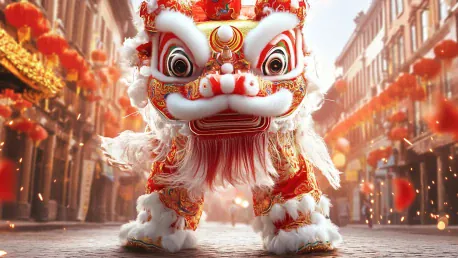As China continues to merge its rich cultural heritage with contemporary advancements, the question arises whether artificial intelligence (AI) is reshaping traditional Lunar New Year celebrations. One notable example of this intersection is the “AI temple fair” held in Beijing during the week-long Lunar New Year festivities. This event serves as a living exhibit of how centuries-old customs can be enhanced with the latest technological innovations, offering an intriguing glimpse into the future of cultural celebrations.
The Intersection of Tradition and Technology
Dancing Robots and Interactive Displays
In a bustling shopping mall, crowds gather to watch a humanoid robot groove to the rhythm of traditional Lunar New Year tunes, capturing the fascination of both the young and the old. This dancing robot is more than just an entertainment piece; it represents the innovative displays that local tech firms have brought to the “AI temple fair.” Located in the upscale Haidian district, this fair offers technology companies a wide-reaching platform to showcase the capabilities of their AI-driven products to a diverse audience. From robots that can brew coffee to those that can fetch items off shelves, the range of tasks these machines can perform is nothing short of impressive.
Amid the various technological wonders, a 48-year-old housewife named Sophia Wu finds herself captivated. To her, these robots aren’t just technological marvels; they are practical helpers that could someday make her daily chores easier. For many visitors, the sight of these robots performing complex tasks is both a spectacle and a practical demonstration of AI’s potential. As Wu watches a robot prepare a lovely cup of coffee, she envisions a future where such conveniences become a regular part of her life. The fair thus highlights not just the novelty of these advancements but their potential to integrate seamlessly into everyday routines.
Human Imitation Robots
One of the standout attractions of the fair is Xiao Xin, a “high-quality human imitation robot” that interacts seamlessly with visitors. This robot’s ability to subtly adjust its prosthetic facial expressions and react in a human-like manner sets it apart from other exhibits. Visitors are often taken aback when Xiao Xin responds to their questions with a slight smile or a furrowed brow, making the interaction feel surprisingly natural. These nuances in Xiao Xin’s design encapsulate the sophistication of modern AI and robotics, providing an almost eerie replication of human characteristics.
Another eye-catching display is the humanoid robot dressed up as China’s traditional wealth god. This robot not only interacts with attendees but also adds a unique cultural touch by sharing details about its “breakfast,” thereby blending humor with tradition. Such exhibits serve as a vivid example of how robotics can preserve cultural symbols while introducing elements of modernity. They engage visitors on both tech and cultural levels, making the experience multifaceted. For many in the crowd, these robots symbolize a harmonious blend of innovation and heritage.
AI Enriching Cultural Practices
Automated Musicians and Calligraphers
The “AI temple fair” doesn’t stop at humanoid robots; it also features an ensemble of automated musicians who perform traditional holiday songs. These robotic musicians collaborate in a synchronized manner, offering renditions that evoke both nostalgia and awe. The blend of old melodies with futuristic performers elicits a unique emotional response, making the experience memorable. Among the crowd, IT professional Bai Song finds himself particularly captivated by the charm of these robotic performers.
While admiring the performance, Bai Song acknowledges that AI’s potential stretches beyond mere entertainment. He sees these robots as emblematic of evolving job landscapes, believing that AI can augment human capabilities rather than replace them. In his view, China’s socialist foundation provides a safety net, making the transition toward more automated roles less daunting. This perspective highlights a significant societal discussion point: AI as a component of evolving professions rather than a disruptor of livelihoods.
The Ambition to Lead in AI
China’s ambition to become a global leader in AI by the end of the decade is underscored by innovations like the AI chatbot R1 from the Chinese start-up DeepSeek. This chatbot promises to challenge American competitors, offering similar services at a fraction of the cost. However, the fair also showcases the hurdles that still need to be overcome. For instance, despite all the groundbreaking advancements, not every robotic display performs flawlessly. A robotic koi carp, for example, repeatedly bumps into the walls of its tank, while semi-automated football teams struggle with rudimentary skills.
Yet, even with these imperfections, there is optimism in the air. Cheng Cheng, a software engineer at Booster Robotics, observes these glitches but remains hopeful about refining these capabilities. He sees the current state of AI robotics not as a setback but as a stepping stone toward more advanced iterations. The fair thus serves as a microcosm of the larger tech industry, reflecting both the incredible strides made and the challenges that lie ahead.
Future Considerations
As China continues to blend its rich cultural heritage with modern advancements, an interesting question arises: Is artificial intelligence (AI) changing the way traditional Lunar New Year celebrations are held? A striking example of this blend is the “AI temple fair” showcased in Beijing during the week-long Lunar New Year festivities. This event meets at the intersection of old customs and new technology, offering a compelling view of how centuries-old traditions can be revitalized through cutting-edge innovations.
The AI temple fair features interactive displays, virtual reality experiences, and AI-driven performances that add a new layer of excitement to the traditional festival. Visitors get to witness how AI can recreate traditional folk stories, dances, and even fortune-telling, all while preserving the essence of the Lunar New Year. This harmonious fusion of past and present not only enhances the celebrations but also makes them more accessible and engaging for the younger generation, ensuring that these cherished traditions continue to thrive in an ever-evolving world.









